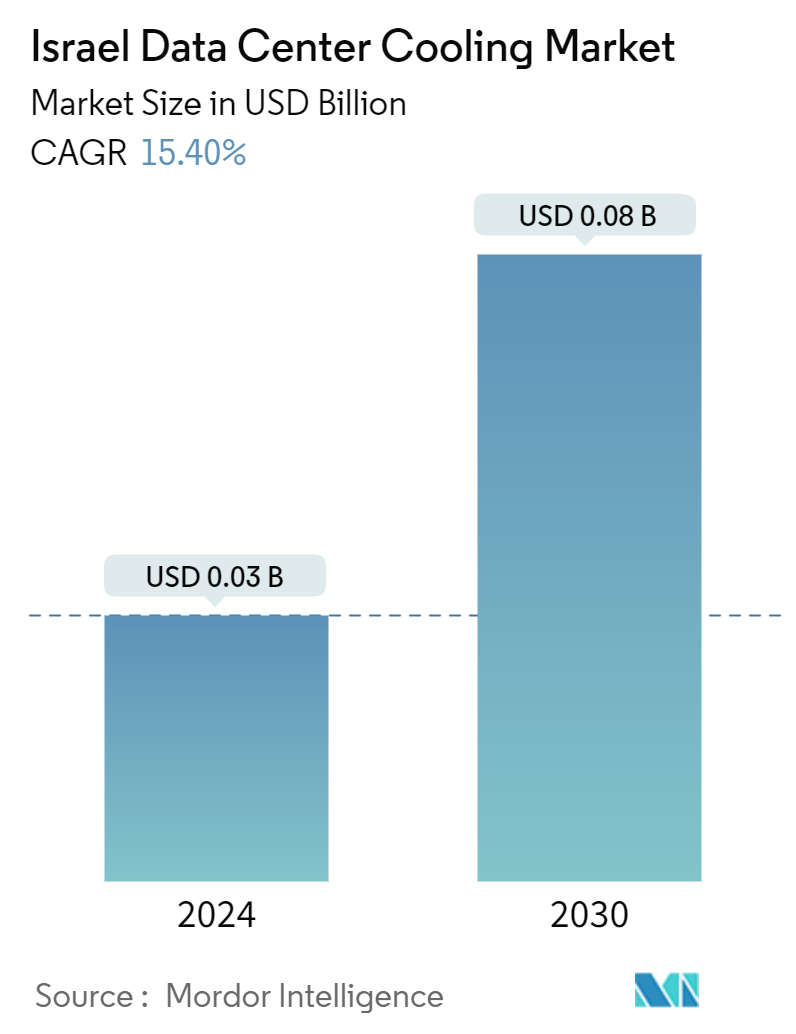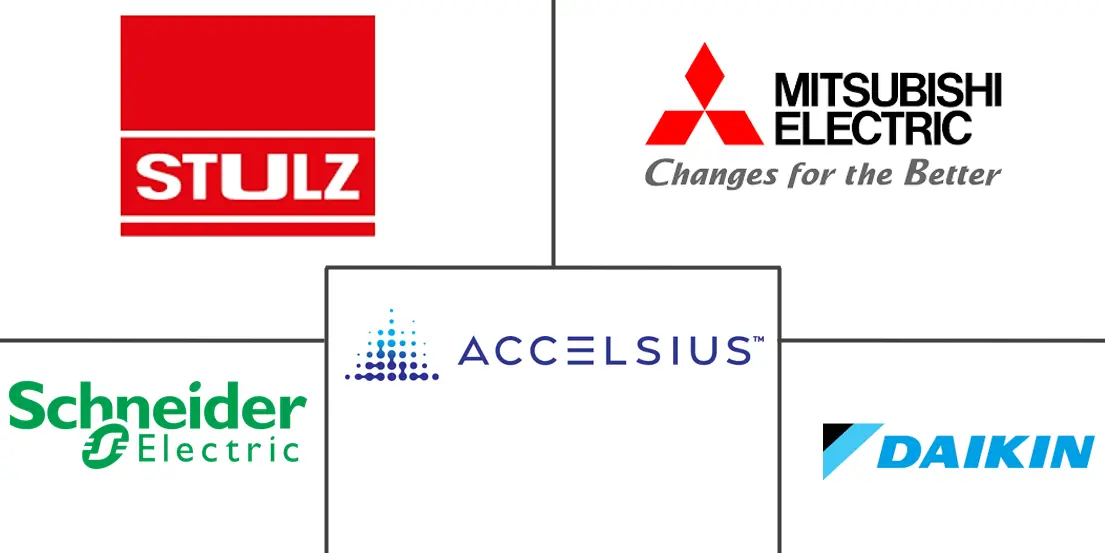Market Size of Israel Data Center Cooling Industry

| Study Period | 2017 - 2030 |
| Base Year For Estimation | 2023 |
| Market Size (2024) | USD 0.03 Billion |
| Market Size (2030) | USD 0.08 Billion |
| CAGR (2024 - 2030) | 15.40 % |
| Market Concentration | Medium |
Major Players
*Disclaimer: Major Players sorted in no particular order |
Israel Data Center Cooling Market Analysis
The Israel Data Center Cooling Market size is estimated at USD 0.03 billion in 2024, and is expected to reach USD 0.08 billion by 2030, growing at a CAGR of 15.40% during the forecast period (2024-2030).
- The increasing demand for cloud computing among SMEs, government regulations for local data security, and growing investment by domestic players are some major factors driving the demand for data centers.
- Under Construction IT Load Capacity: The IT load capacity of the Israeli data center cooling market is expected to surpass 426 MW by 2030.
- Under Construction Raised Floor Space: The country's construction of raised floor area is expected to increase by more than 1.5 million sq. ft by 2030.
- Planned Racks: The country's total number of racks to be installed is expected to reach 76K units by 2029. Tel Aviv is expected to house the maximum number of racks by 2030.
- Planned Submarine Cables: There are several submarine cables under construction. One such cable, Blue, is estimated to start service in 2024. It stretches over 4,696 kilometers and has landing points from Tel Aviv.
- New data centers across the country are focusing on implementing state-of-the-art monitoring systems to mitigate the risks associated with extreme weather events. Many use the latest, more energy-efficient cooling technologies, such as redundant cooling systems, smart monitoring technologies, and backup power generators, to ensure consistency of temperature in the event of power interruptions. Direct liquid cooling uses a higher thermal transfer of water to a more efficient cooling device.
- The average winter temperature is between 5 °C (40 °F) and 15 °C (60 °F), and the average summer temperature is between 27 °C (80 °F) and over 32 °C (90 °F). Winters can vary widely across the country, with frequent cold, fog, and snow periods in the north and more pleasant weather in the south. DC cooling is done in the DC facilities depending on climatic conditions.
Israel Data Center Cooling Industry Segmentation
Data center cooling is a set of techniques and technologies to maintain optimal operating temperatures in data center environments. Data center cooling is important because data centers house many computer servers and network equipment that generate heat during operation. Efficient cooling systems are used to dissipate this heat and prevent equipment from overheating, ensuring continued reliable operation of the data center. Various methods, such as air conditioning, liquid cooling, and hot/cold aisle containment, are commonly used to control temperature and humidity in data centers.
The Israeli data center cooling market is segmented by technology (air-based cooling (chiller and economizer, CRAH, cooling towers, and others), liquid-based cooling (immersion cooling, direct-to-chip cooling, and rear-door heat exchanger)), type of data center (hyperscaler, enterprise, and colocation), and end-user industry (IT and telecom, retail and consumer goods, healthcare, media and entertainment, federal and institutional agencies, and other end-user industries).
| By Cooling Technology | ||||||
| ||||||
|
| By Type | |
| Hyperscalers (owned & Leased) | |
| Enterprise (On-premise) | |
| Colocation |
| By End user Vertical | |
| IT & Telecom | |
| Retail & Consumer Goods | |
| Healthcare | |
| Media & Entertainment | |
| Federal & Institutional agencies | |
| Other end-users |
Israel Data Center Cooling Market Size Summary
The Israeli data center cooling market is poised for significant growth, driven by the increasing demand for cloud computing, stringent government regulations on data security, and substantial investments from local players. The market is characterized by the adoption of advanced cooling technologies, such as liquid cooling and smart monitoring systems, to address the challenges posed by extreme weather conditions. These technologies are not only energy-efficient but also offer precise temperature control, which is crucial for maintaining the performance of high-density computing environments. The market's expansion is further supported by the development of new data centers equipped with state-of-the-art cooling solutions, ensuring reliability and efficiency in operations.
Tel Aviv emerges as a central hub for data center activities in Israel, benefiting from its proximity to key government facilities, technological resources, and robust internet connectivity. The region's strategic location and infrastructure make it an attractive destination for data center investments. The market is fragmented, with major players like Schneider Electric, Rittal, and Mitsubishi Electric actively contributing to its growth through innovative cooling solutions and strategic partnerships. Recent developments, such as Carrier Global's collaboration with Strategic Thermal Labs and Vertiv's acquisition of Cooltera Ltd, highlight the ongoing advancements in data center cooling technologies. These initiatives are expected to enhance the efficiency and scalability of cooling systems, supporting the burgeoning demand for data centers in Israel.
Israel Data Center Cooling Market Size - Table of Contents
-
1. MARKET INSIGHTS
-
1.1 Market Overview
-
1.2 Key cost considerations for Cooling
-
1.2.1 Analysis of the key cost overheads related to DC operations with an eye on DC Cooling
-
1.2.2 Comparative Study of the cost and operational considerations related to each Cooling technology based on key factors such as design complexity, PUE, advantages, drawbacks, extent of utilization of natural weather conditions)
-
1.2.3 Key innovations and developments in Data Center Cooling
-
1.2.4 Key energy efficiency practices adopted in Data Centers
-
-
-
2. MARKET SEGMENTATION
-
2.1 By Cooling Technology
-
2.1.1 Air-based Cooling
-
2.1.1.1 Chiller and Economizer
-
2.1.1.2 CRAH
-
2.1.1.3 Cooling Tower (covers direct, indirect & two-stage cooling)
-
2.1.1.4 Others
-
-
2.1.2 Liquid-based Cooling
-
2.1.2.1 Immersion Cooling
-
2.1.2.2 Direct-to-Chip Cooling
-
2.1.2.3 Rear-Door Heat Exchanger
-
-
-
2.2 By Type
-
2.2.1 Hyperscalers (owned & Leased)
-
2.2.2 Enterprise (On-premise)
-
2.2.3 Colocation
-
-
2.3 By End user Vertical
-
2.3.1 IT & Telecom
-
2.3.2 Retail & Consumer Goods
-
2.3.3 Healthcare
-
2.3.4 Media & Entertainment
-
2.3.5 Federal & Institutional agencies
-
2.3.6 Other end-users
-
-
Israel Data Center Cooling Market Size FAQs
How big is the Israel Data Center Cooling Market?
The Israel Data Center Cooling Market size is expected to reach USD 0.03 billion in 2024 and grow at a CAGR of 15.40% to reach USD 0.08 billion by 2030.
What is the current Israel Data Center Cooling Market size?
In 2024, the Israel Data Center Cooling Market size is expected to reach USD 0.03 billion.

